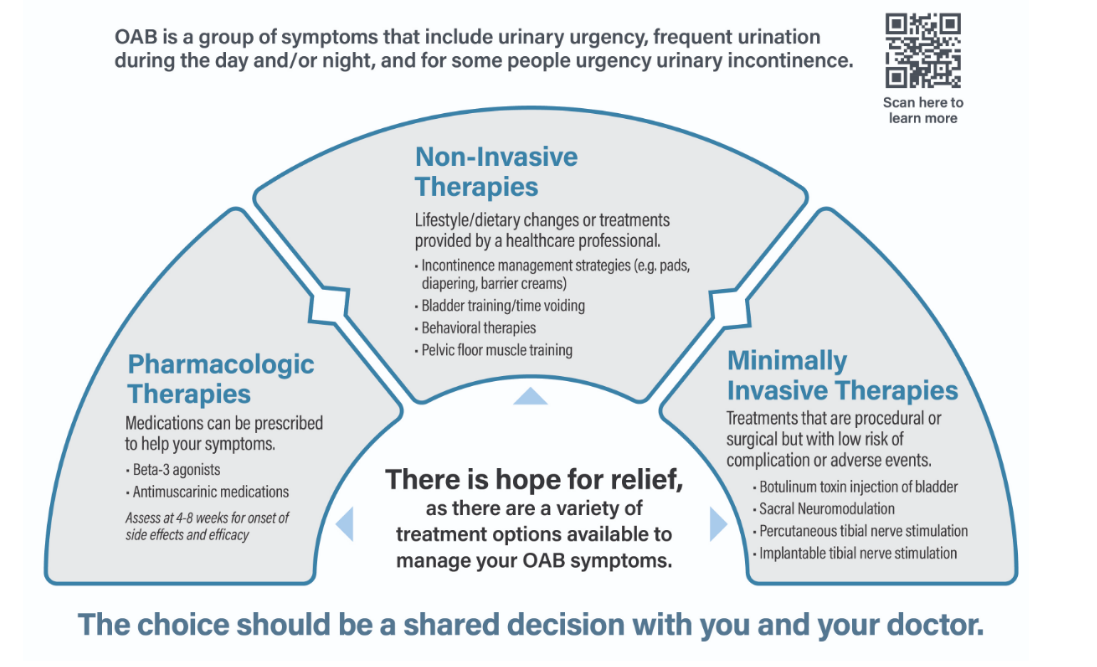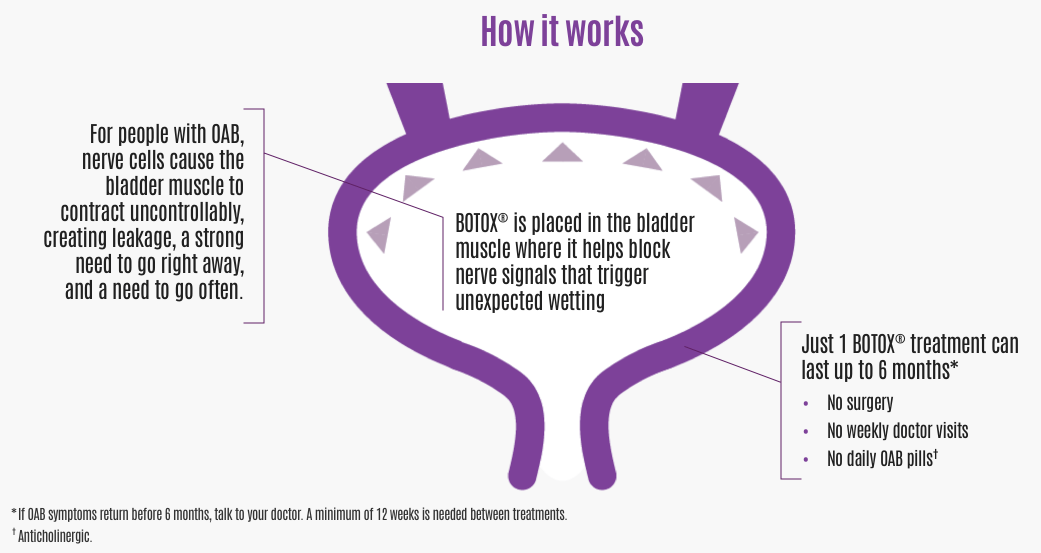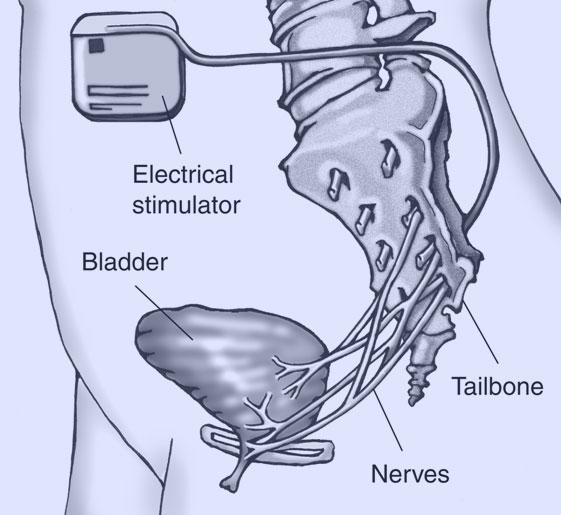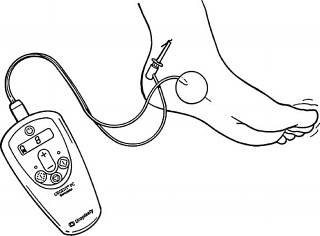Overactive Bladder (OAB)
Bladder control problems affect tens of millions of people every day, and many people are reluctant to talk about it
- Do you go more than 8 times per day?
- Are you urinating often or frequently (i.e., peeing a lot)?
- Are you asking yourself ,“Why do I have to pee so much?”
If so, you might be dealing with OAB.
Symptoms of Overactive Bladder
Overactive bladder can manifest through the following symptoms:
- Urgency: An uncontrollable urge to urinate.
- Frequency: The need to urinate more than 8 times in a 24-hour period.
- Urge Incontinence: Leakage or accidents that occur before you can reach the bathroom.
These symptoms can significantly affect daily life and social activities, causing frustration and isolation.

Overactive bladder can significantly impact quality of life, affecting daily activities and leading to social isolation. When overactive bladder symptoms are bothersome, our team at Texas Tech Urology is here to offer treatment!
Listen to Kristen Sharma, our nurse practitioner, discuss overactive bladder and an overview of the treatment on The Med Edit Podcast.
In most cases, the exact cause of OAB is unknown (idiopathic). However, several factors may contribute:
Causes
- Neurological Disorders: Conditions like Parkinson's disease, multiple sclerosis, and stroke can impact nerve signals that control the bladder.
- Age-Related Changes: As people age, changes in the bladder muscle and its ability to stretch and contract may lead to OAB.
- Hormonal Changes: Particularly in postmenopausal women, decreased estrogen levels can affect bladder function.
- Obesity: Excess weight increases pressure on the bladder, potentially worsening symptoms. Learn more
- Diabetes: Uncontrolled diabetes can lead to bladder irritation and nerve damage, further contributing to OAB.
Diagnosis of Overactive Bladder
A thorough diagnosis is essential for effective treatment. It typically includes:
- Patient History: Documenting the frequency and urgency of symptoms.
- Genitourinary Exam: A physical exam, including a pelvic exam for women or prostate exam for men.
- Bladder Diary: Keep track of fluid intake and urination patterns. Download a Bladder Diary App or use a Printable Form.
- Urinalysis: A test to rule out infections or blood in the urine.
- Post-Void Residual Measurement: A test to determine how much urine is left in the bladder after urination. This can be done with a small ultrasound machine or a catheter.
Treatment Options for Overactive Bladder
There are various treatment options available. Through collaboration with your healthcare provider, you can find a treatment plan that works best for you. It’s common for a patient to try several therapies, either alone or in combination, until they find what’s right for them. There is no specific order intended for treatment. It is important to optimize contributing medical conditions when treating overactive bladder. These may include:

Behavioral Therapies
Behavioral Therapies
- Fluid Management: Regulating fluid intake can help reduce symptoms. Too much fluid can exacerbate symptoms. Too little fluid will mean the urine is concentrated, which is irritating to the bladder and can worsen symptoms.
- Dietary Changes: Avoiding bladder irritants like caffeine, alcohol, and spicy foods. Learn More
- Bladder Training: Scheduled voiding and gradually increasing the time between bathroom visits. This can be just as effective as medication when done consistently. “Quick flicks” to suppress urinary urges can also help. Learn More
- Pelvic Floor Exercises (Kegel Exercises): Strengthen pelvic muscles to improve bladder control. A pelvic floor therapist can help if you struggle with performing Kegels. If you have chronic pelvic pain, exercises without guidance can make pain worse. Learn More
Optimizing Other Medical Conditions
Optimizing Other Medical Conditions
- Genitourinary Syndrome of Menopause (GSM): Vaginal estrogen can help improve symptoms for peri/postmenopausal women.
- Constipation: Preventing and managing constipation can help with better bladder control. Learn More
- Obesity: Weight reduction can alleviate bladder pressure.
- Pelvic Organ Prolapse (POP): Prolapse can interfere with the ability of the bladder to empty fully. Treating prolapse can help with overactive bladder symptoms.
- Sleep Apnea: Control of sleep apnea often improves nighttime urinary symptoms.
- Smoking: Quitting smoking helps reduce bladder irritation and lowers the risk of bladder cancer, often all made worse by nicotine.
Medications
Medications
Medications are often used to reduce OAB symptoms:
- Anticholinergics (oxybutynin, solifenacin, etc.): Help prevent bladder muscle contractions, reducing urgency.
- Beta-3 Adrenergic Agonists (mirabegron, vibegron): Relax the bladder muscle to reduce urgency and frequency.
A trial of medication should last 4-8 weeks to determine its effectiveness. For persistent symptoms, a combination of medications may be recommended.
Minimally Invasive Therapies

Botox Injections
- Cystoscopic injections (hyperlink to cystoscopy) administered into the bladder muscle to reduce contractions.
- Must be repeated 1-2 times per year to maintain efficacy Learn More
Sacral Neuromodulation
A "bladder pacemaker" that changes how the brain, spinal cord, and bladder communicate. Can also help with fecal incontinence. Learn More



Percutaneous Tibial Nerve Stimulation
Weekly 30-minute office-based treatments for 12 weeks, followed by maintenance therapy. Learn More
Surgical Options
Surgical Options
In severe cases, surgical interventions may be necessary:
- Bladder Augmentation: Increasing bladder capacity using a section of the intestine.
- Urinary Diversion: Rerouting urine flow away from the bladder.
How We Can Help
Overactive bladder can be a challenging condition, but with an accurate diagnosis and comprehensive treatment plan, many patients experience significant improvement. At Texas Tech Physicians Urology, we offer personalized care and management strategies.
For more information, check out our resources:
Next Steps
Looking for your next step? Check out the links at the top of this page for options to "Pay my Bill", "Referrals", and more.